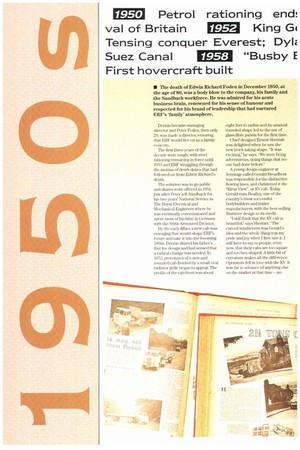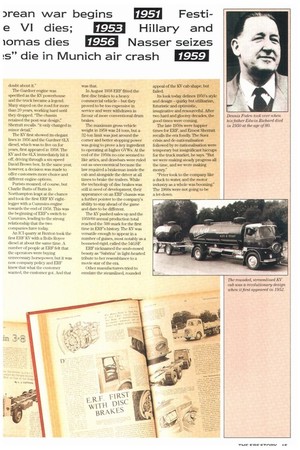MI The death of Edwin Richard Foden in December 1950,
Page 170

Page 171

If you've noticed an error in this article please click here to report it so we can fix it.
at the age of SO, was a body blow to the company, his family and the Sandbach workforce. He was admired for his acute business brain, renowned for his sense of humour and respected for his brand of leadership that had nurtured ERF's 'family' atmosphere.
Dennis became managing director and Peter Foden, then only 20, was made a director, ensuring that ERE would live on as a family concern.
The first three years of the decade were tough, with steel rationing remaining in force until 1953 arid ERF struggling through the morass of death duties that had followed on from Edwin Richard's death.
The solution was to go public and shares were offered in 1954, just idler Peier left Sandbach for las two years' National Service in The Royal Electrical and Mechanical Engineers where he was eventually commissioned and spent most of his time in Germany with the Sixth Armoured Division.
By t he early fifties a new cab was emerging that would shape ERFs future and take It into the booming 1960s. Dennis shared his father's flair for design and had sensed that a radical change was needed. In 1952, moil imies of a new and rounded cab fronted by a small oval radiator grille began to appear The pi Ally of the cab front was about
eight feet in radius and its unusual rounded shape led to the use of glass fibre panels for the first time.
Chief designer Ernest Sherratt was delighted when he saw the new truck taking shape. "It was exciting' he says. "We were being adventurous, doing things that noone had done before."
A young design engineer at Jennings called Gerald Broadbent was responsible for the distinctive flowing lines, and christened it the "Klear View", or KV cab. 'Ibday Gerald runs Boalloy, one of the country's most successful bodybuilders and trailer manufacturers, with the lx•st-selling Tautliner design to its credit.
"I still think that the KV cab is beautiful," says Sherratt 'The curved windscreen was Gerald's idea and the wittily thing was my pride and joy when I first saw it. I still have to say to people, even now, that their cabs are too square and too box shaped. A little bit of curvature makes all the difference. Operators fell in hive with the KV. It was far in advance of anything else on the market at that time no doubt about it."
The Gardner engine was specified as the KV powerhouse and the truck became a legend. Many stayed on the road for more than 20 years, working hard until they dropped. The chassis retained the post-war design," Sherratt recalls. "it only changed in minor detail."
The KV first showed its elegant lines in 1956 and the Gardner 6LX diesel, which was to live on for years, first appeared in 1958. The KV and the 61-X immediately hit it off, driving through a six-speed David Brown box. In the same year, however, a decision was made to offer customers more choice and different engine options.
Purists moaned, of course, but Charlie Butts of Butts in Northampton leapt at the chance and took the first ERF KV eightlegger with a Cummins engine towards the end of 1958. This was the beginning of ERF's switch to Cummins, leading to the strong relationship that the two companies have today.
An ICI quarry at Buxton took the first ERF KV with a Rolls Royce diesel at about the same time. A number of people at ERF felt that the operators were buying unnecessary horsepower, hut it was now company policy and ERF knew that what the customer wanted, the customer got. And that
was that.
In August. 1958 ERF' fitted the first disc brakes to a heavy commercial vehicle but they proved to be too expensive in service and were withdrawn in favour of more conventional drum brakes.
The maximum gross vehicle weight in 1958 was 24 tons, but a 32-ton limit was just around the corner and better stopping power was going to prove a key ingredient to operating at higher GVWs. At the end of the 1950s no-one seemed to like artics, and drawbars were ruled out as uneconomical because the law required a brakeman inside the cab and alongside the driver at all times to brake the trailers. While the technology of disc brakes was still in need of development, their appearance on an ERF chassis was a further pointer to the company's ability to stay ahead of the game and dare to be different.
The KV pushed sales up and the 1959/60 annual production total reached the 500 mark for the first time in ERrs history The KV was versatile enough to appear in a number of guises, most notably as a bonneted rigid, called the 54GSF.
ERF nicknamed the snub-nosed beauty as "Sabrina" in light-hearted tribute to her resemblance to a movie star of the era.
Other manufacturers tried to emulate the steandined, rounded appeal of the KV cab shape, but
Its look today defines 1950's style and design quirky but utilitarian, futuristic and optimistic, imaginative and resourceful After two hard and gloomy decades, the good times were coming.
The late 1950s were happier times for ERF, and Ernest Sherratt recalls the era fondly The Suez crisis and de-nationalisation followed by re-nationalisation were temporary but insignificant hiccups for the truck market, he says. "But we were making steady progress all the time, and we were malting money"
"Peter took to the company like a duck to water, and the motor industry as a whole was booming." The 1960s were not going to be a let-down.




































































































































































































